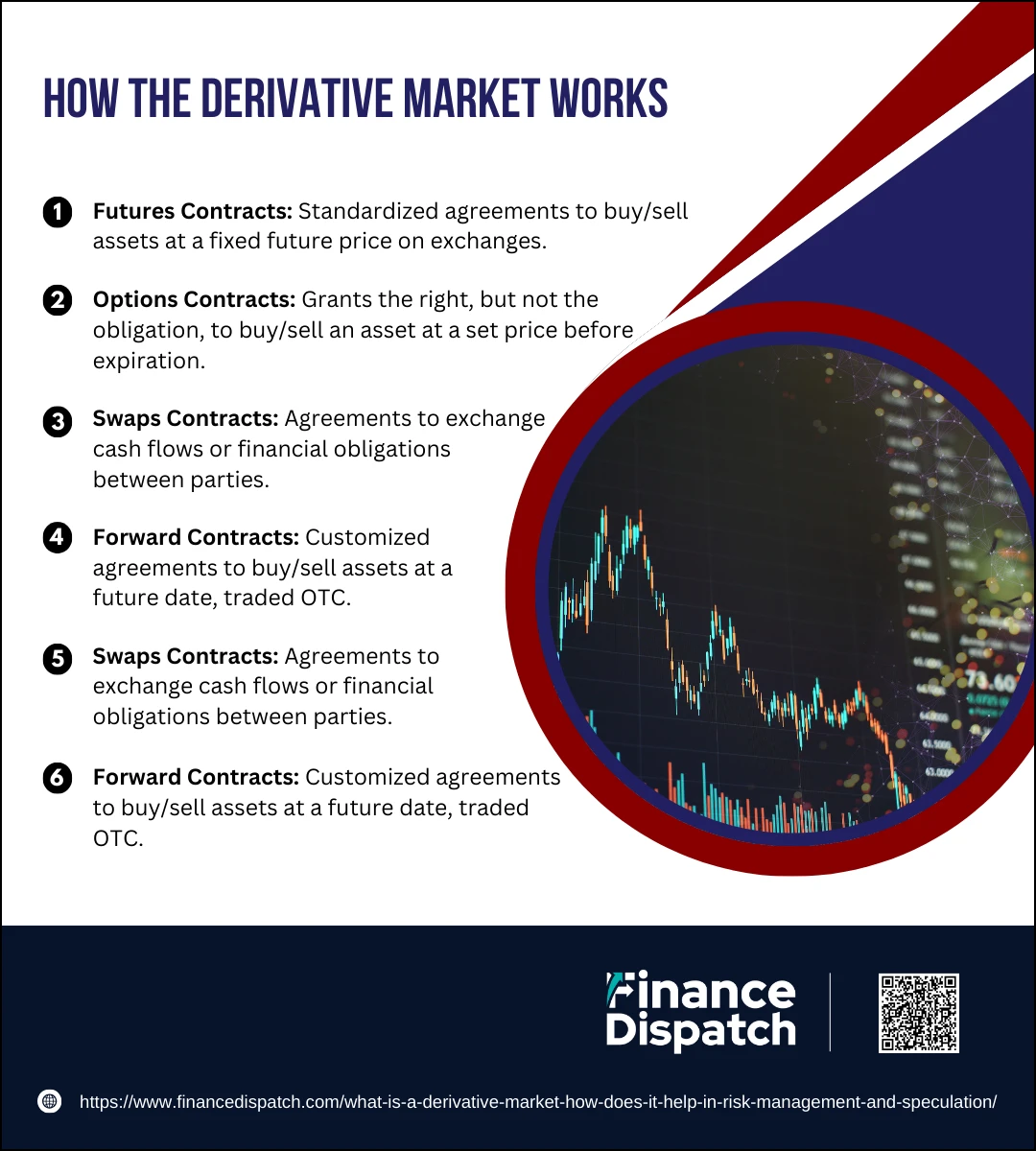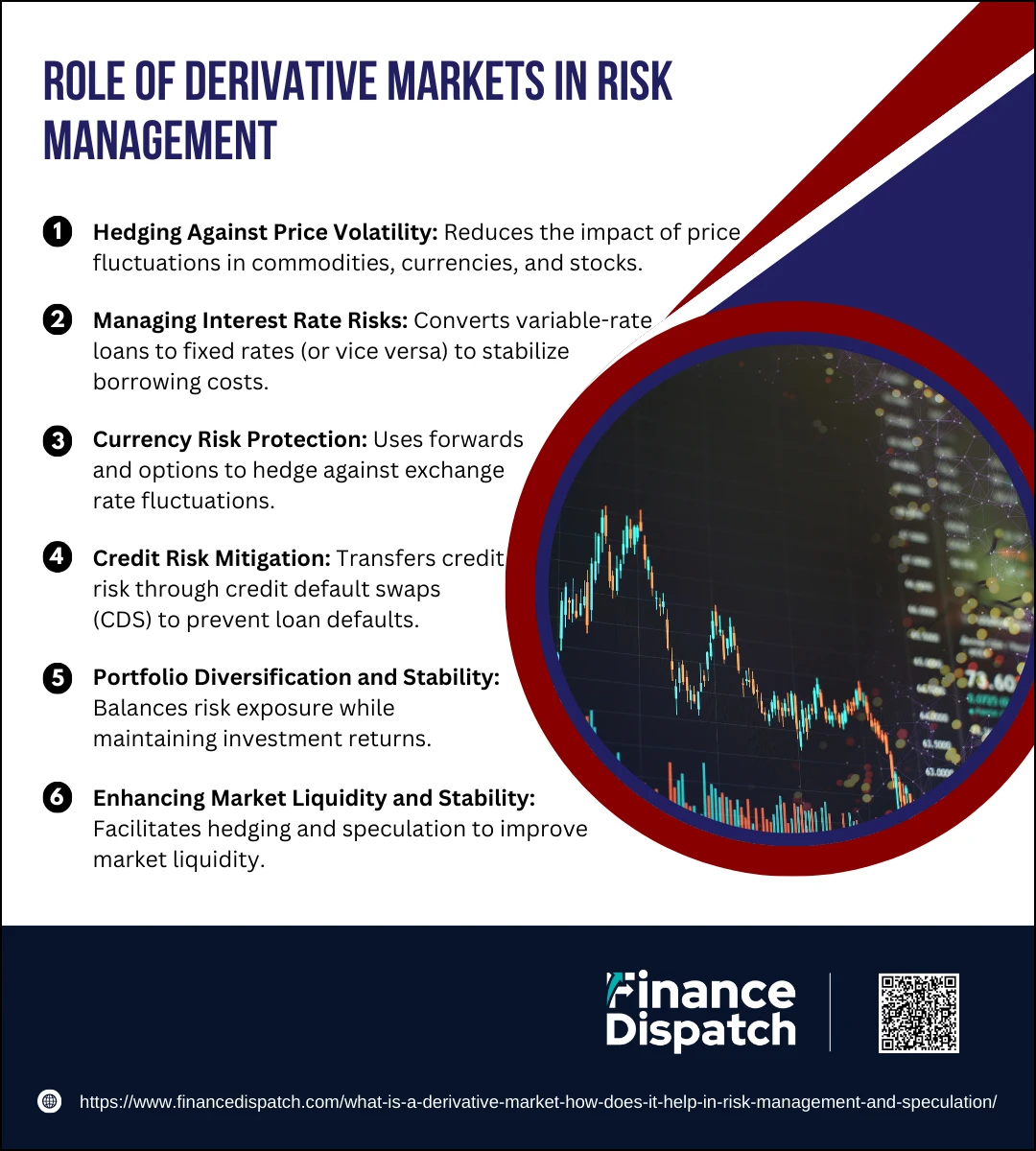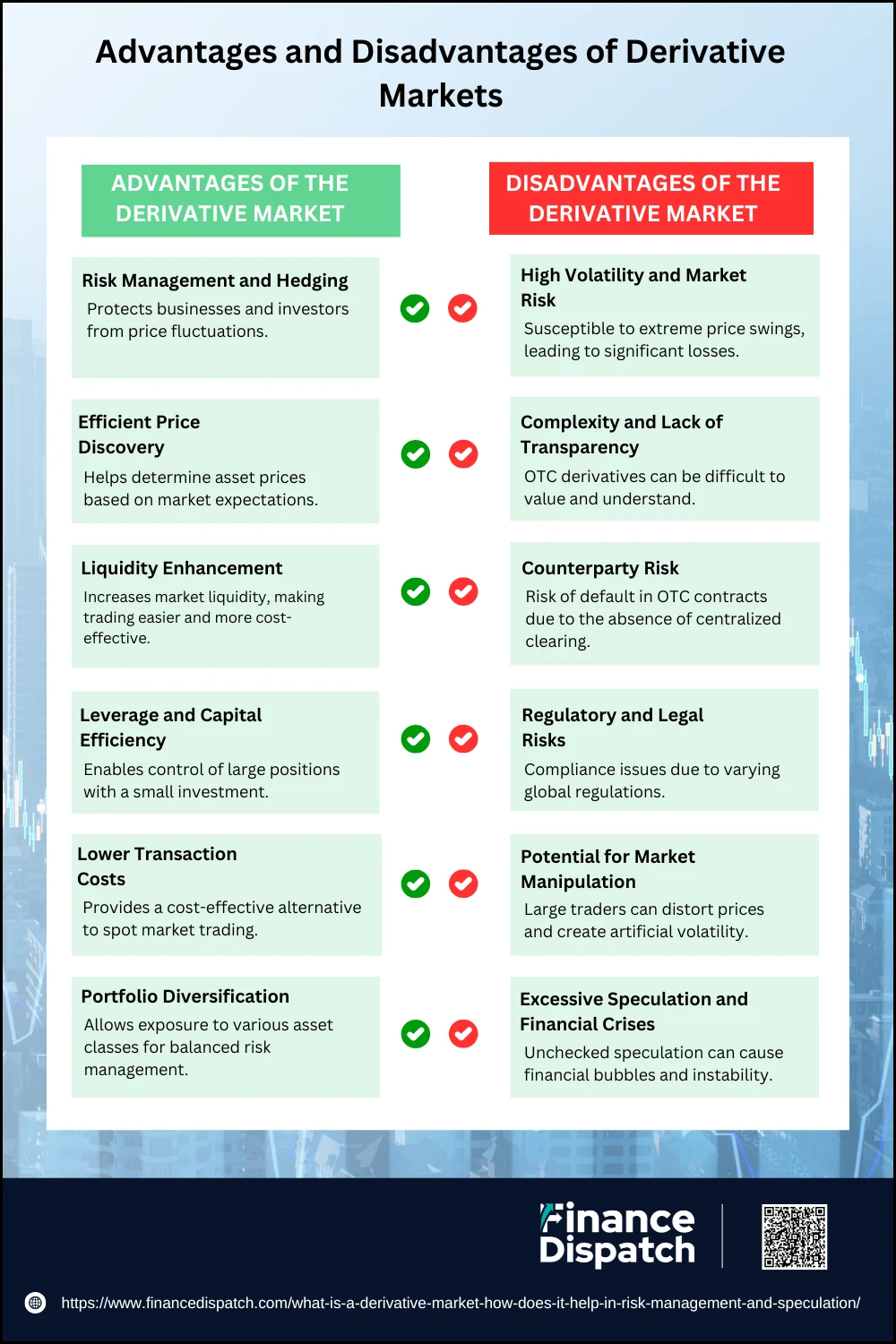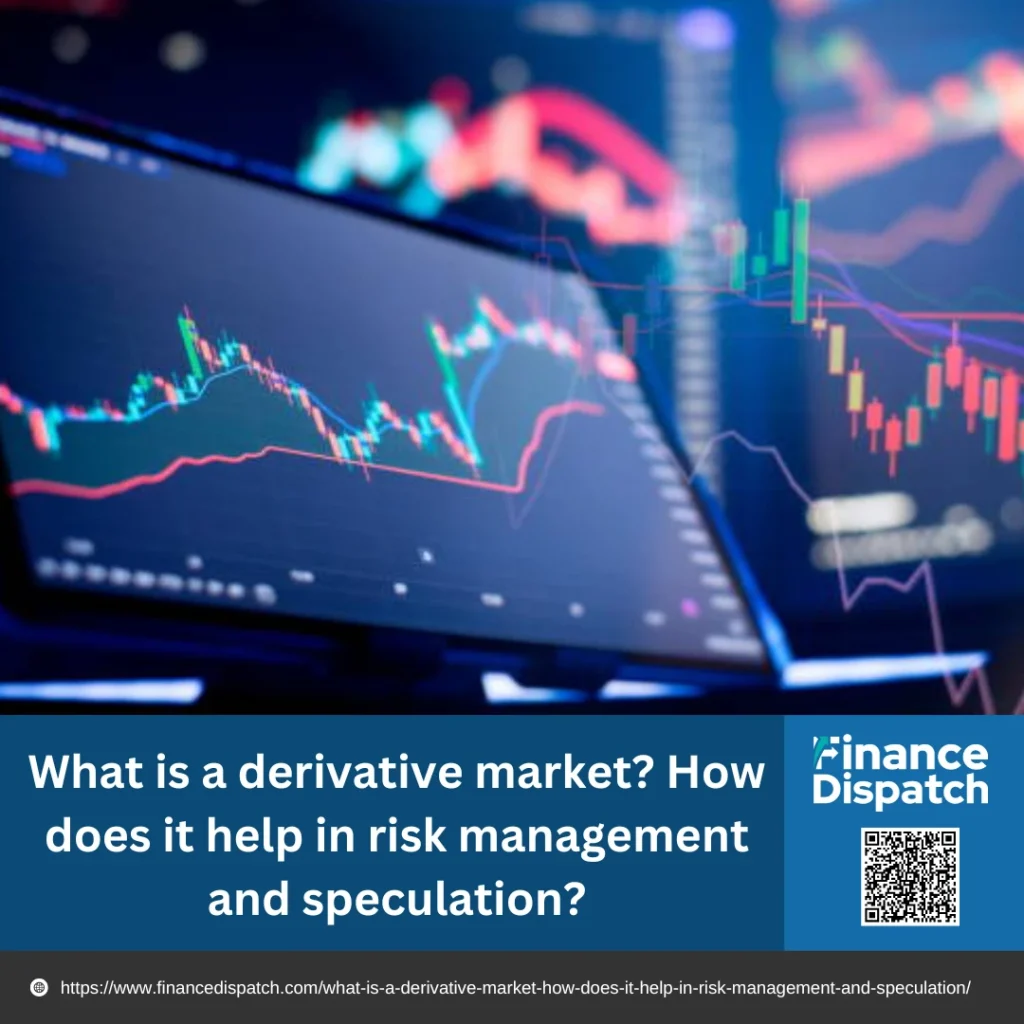The derivative market plays a crucial role in modern finance, enabling investors, businesses, and traders to manage risk, enhance market efficiency, and capitalize on price movements. A derivative is a financial instrument whose value is derived from an underlying asset, such as stocks, commodities, currencies, or interest rates. These instruments allow market participants to hedge against potential losses or speculate on future price changes to generate profits. By offering tools for risk management and speculation, derivative markets contribute to liquidity, price discovery, and financial stability. However, their complexity and leveraged nature also introduce risks that require careful navigation. In this article, we will explore the fundamentals of the derivative market, its role in risk management, and its use in speculative trading.
What is Derivative Market?
A derivative market is a financial marketplace where contracts known as derivatives are traded. These contracts derive their value from an underlying asset, such as stocks, bonds, commodities, currencies, or interest rates. Unlike spot markets, where assets are bought and sold for immediate delivery, derivative markets involve agreements to trade assets at a predetermined price on a future date. The primary purpose of derivatives is to manage financial risks by allowing businesses and investors to hedge against adverse price movements. Additionally, they provide opportunities for speculation, where traders attempt to profit from market fluctuations. Derivative markets play a crucial role in enhancing liquidity, enabling price discovery, and offering leverage, but they also carry risks due to their complexity and high volatility.
 Types of Derivatives
Types of Derivatives
Derivatives are financial instruments whose value is derived from an underlying asset, such as stocks, commodities, currencies, or interest rates. They are widely used for hedging risks, speculating on price movements, and improving market efficiency. Depending on their structure and purpose, derivatives can be classified into different types, each serving distinct financial needs. Below are the four major types of derivatives:
1. Futures Contracts
A futures contract is a standardized agreement between two parties to buy or sell an underlying asset at a predetermined price on a specified future date. These contracts are traded on regulated exchanges, making them transparent and less risky than over-the-counter (OTC) derivatives. Common futures contracts include stock index futures, commodity futures (such as crude oil or gold), and interest rate futures.
2. Options Contracts
Options give the buyer the right, but not the obligation, to buy (call option) or sell (put option) an underlying asset at a fixed price before or on a specific expiration date. The seller of the option, however, is obligated to fulfill the contract if the buyer exercises the option. Options are widely used for hedging price risks and speculative trading in stock markets, commodities, and currencies.
3. Swaps Contracts
A swap contract is an agreement between two parties to exchange cash flows or liabilities based on different financial instruments. The most common types include interest rate swaps, where fixed and floating interest rate payments are exchanged, and currency swaps, which help multinational companies hedge foreign exchange risks. Swaps are generally customized contracts traded over-the-counter (OTC) rather than on formal exchanges.
4. Forward Contracts
A forward contract is similar to a futures contract but is customized and traded in OTC markets instead of exchanges. In a forward contract, two parties agree to buy or sell an asset at a future date for a price agreed upon today. Since these contracts are not standardized, they offer flexibility but also carry higher counterparty risks compared to exchange-traded futures.
 How the Derivative Market Works?
How the Derivative Market Works?
The derivative market functions as a platform where financial contracts, known as derivatives, are traded. These contracts derive their value from an underlying asset, such as stocks, commodities, bonds, currencies, or interest rates. Unlike spot markets where assets are exchanged immediately, derivative markets involve agreements to buy or sell assets at a future date. Traders use derivatives for hedging against risks, speculating on price movements, or arbitraging price differences between markets. The market operates through exchange-traded derivatives (ETD), which are standardized and regulated, and over-the-counter (OTC) derivatives, which are privately negotiated and carry higher counterparty risks. Below is a step-by-step breakdown of how the derivative market works:
1. Creation of a Derivative Contract
A derivative contract is initiated between two parties, outlining the terms, including the underlying asset, contract price, expiration date, and settlement method.
2. Trading of Derivative Contracts
Derivatives can be traded on:
- Exchanges (e.g., Chicago Mercantile Exchange) – Standardized contracts with regulatory oversight.
- Over-the-Counter (OTC) Markets – Customized contracts negotiated privately between parties.
3. Price Determination and Market Movements
The value of derivatives fluctuates based on supply and demand, the price of the underlying asset, interest rates, and market sentiment.
4. Hedging and Speculation
- Hedgers use derivatives to reduce financial risks (e.g., a farmer hedging against crop price fluctuations).
- Speculators trade derivatives to profit from price changes without owning the underlying asset.
5. Leverage and Margin Requirements
Traders can control large positions with a smaller initial investment through leverage. However, they must maintain a margin account to cover potential losses.
6. Settlement of Contracts
Derivatives are settled either by:
- Cash Settlement – The difference between the contract price and the asset’s market price is exchanged.
- Physical Delivery – The underlying asset is exchanged as per contract terms.
 Role of Derivative Markets in Risk Management
Role of Derivative Markets in Risk Management
The derivative market plays a crucial role in managing financial risks by allowing businesses, investors, and traders to protect themselves against adverse price movements. By using derivative instruments such as futures, options, swaps, and forwards, market participants can hedge against fluctuations in stock prices, interest rates, exchange rates, and commodity prices. These financial contracts enable companies to lock in prices, minimize uncertainties, and maintain financial stability. Below are the key ways in which the derivative market helps in risk management:
1. Hedging Against Price Volatility
Derivatives allow businesses and investors to reduce the impact of price fluctuations in commodities, currencies, and stocks. For example, a farmer can use futures contracts to lock in a selling price for crops, ensuring stability despite market uncertainties.
2. Managing Interest Rate Risks
Financial institutions and corporations use interest rate swaps to convert variable-rate loans into fixed-rate loans (or vice versa), protecting themselves from sudden changes in interest rates that could impact borrowing costs.
3. Currency Risk Protection
Multinational companies engaged in foreign trade use currency forwards and options to hedge against exchange rate fluctuations, ensuring that revenues and costs remain predictable despite market changes.
4. Credit Risk Mitigation
Credit default swaps (CDS) allow financial institutions to transfer credit risk from one party to another, providing protection against loan defaults and financial instability.
5. Portfolio Diversification and Stability
Institutional investors use derivatives to balance their portfolios by reducing exposure to high-risk assets while maintaining returns through hedging strategies.
6. Enhancing Market Liquidity and Stability
By facilitating hedging and speculation, the derivative market improves liquidity, making it easier for investors to enter and exit positions, thereby reducing the impact of large price swings.
Speculation in the Derivative Market
Speculation in the derivative market involves traders and investors using derivative instruments, such as futures, options, swaps, and forwards, to profit from anticipated price movements in underlying assets. Unlike hedging, which aims to minimize risks, speculation is focused on maximizing returns by predicting market trends. Speculators play a crucial role in enhancing market liquidity and price discovery, but their actions can also lead to high volatility and financial risks. Below is a comparison of the advantages and risks of speculation in the derivative market:
Table: Advantages and Risks of Speculation in the Derivative Market
| Aspect | Advantages | Risks |
| Profit Potential | High returns from price fluctuations. | High losses if market moves against predictions. |
| Market Liquidity | Provides liquidity, making it easier to trade. | Excessive speculation can increase market volatility. |
| Leverage | Small capital controls large positions. | Amplifies both gains and losses significantly. |
| Price Discovery | Helps determine fair market prices for assets. | Can lead to temporary price distortions. |
| Diversification | Allows investors to trade multiple asset classes. | Requires deep market knowledge to avoid misjudgments. |
| Regulatory Concerns | Encourages active trading and market efficiency. | Excessive speculation may lead to financial bubbles. |
 Advantages and Disadvantages of Derivative Markets
Advantages and Disadvantages of Derivative Markets
The derivative market plays a crucial role in modern finance by providing investors and businesses with tools to hedge risks, speculate on price movements, and enhance market liquidity. While derivatives offer significant benefits, such as price discovery, leverage, and risk management, they also come with inherent risks, including market volatility, counterparty risk, and complexity. Below is a breakdown of the key advantages and disadvantages of the derivative market.
Advantages of the Derivative Market
1. Risk Management and Hedging
One of the most important benefits of derivatives is their ability to mitigate financial risk. Businesses and investors use derivatives to protect themselves against price fluctuations in assets like oil, currencies, or interest rates. For example, an airline company might use futures contracts to lock in fuel prices, ensuring predictable operating costs despite volatile oil prices.
2. Efficient Price Discovery
Derivative markets play a crucial role in determining asset prices based on supply, demand, and future expectations. The prices of futures and options contracts reflect market participants’ outlook on economic conditions, helping guide investment decisions.
3. Liquidity Enhancement
The high trading volume in derivative markets improves liquidity, making it easier for investors to enter and exit positions without significant price changes. Liquid markets reduce transaction costs and enhance overall financial stability.
4. Leverage and Capital Efficiency
Derivatives allow traders to control large market positions with a small initial investment. While this increases the potential for profit, it also exposes traders to amplified losses, making risk management essential.
5. Lower Transaction Costs
Compared to trading in the spot market, derivative contracts often come with lower transaction costs, making them cost-effective for both hedgers and speculators.
6. Portfolio Diversification
Investors use derivatives to diversify their portfolios by gaining exposure to different asset classes without directly buying or selling the assets. This helps in balancing risk and reducing the impact of negative market movements.
Disadvantages of the Derivative Market
1. High Volatility and Market Risk
While derivatives can provide profit opportunities, they are also prone to extreme price fluctuations, which can lead to massive losses. The 2008 financial crisis was partly caused by excessive speculation in derivatives, leading to systemic market failures.
2. Complexity and Lack of Transparency
Some derivatives, particularly over-the-counter (OTC) contracts, are highly complex and difficult to understand. Mispricing, valuation errors, and miscalculations can lead to financial instability.
3. Counterparty Risk
OTC derivatives, unlike exchange-traded contracts, lack centralized clearing, meaning parties are exposed to default risk if one side fails to meet contractual obligations. This risk can increase during economic downturns, causing liquidity crises.
4. Regulatory and Legal Risks
Derivative markets operate under complex regulatory frameworks, which vary across countries. Unexpected regulatory changes can impact market participants, leading to legal uncertainties and compliance issues.
5. Potential for Market Manipulation
Large market participants, such as institutional investors, can manipulate derivative prices, causing artificial volatility and misleading other traders. Unchecked speculation can distort real asset prices, negatively impacting businesses and consumers.
6. Excessive Speculation and Financial Crises
While speculation adds liquidity, excessive speculation can lead to financial bubbles and economic instability. During the global financial crisis of 2008, banks and hedge funds heavily invested in complex derivatives, such as mortgage-backed securities (MBS) and credit default swaps (CDS), leading to severe economic consequences.
Key Players in the Derivative Market
The derivative market consists of various participants, each playing a crucial role in maintaining market efficiency, liquidity, and risk management. These key players engage in derivative trading for different purposes, including hedging, speculation, and arbitrage. Some aim to reduce financial risks, while others seek to profit from market fluctuations. Understanding the roles of these participants helps in grasping the dynamics of the derivative market. Below are the four primary players in the derivative market:
1. Hedgers – Risk Managers
Hedgers use derivatives to protect themselves from adverse price movements in the underlying asset. They are businesses, financial institutions, or investors who aim to stabilize their financial positions by reducing uncertainty.
Example: A wheat farmer may use futures contracts to lock in a selling price for their crops, ensuring profitability regardless of market fluctuations.
2. Speculators – Profit Seekers
Speculators trade derivatives with the goal of profiting from price changes rather than reducing risk. They take high-risk positions based on market predictions, aiming for potential large returns.
Example: A trader buys options contracts on stocks, expecting the price to rise and generate profits. However, if the market moves against them, they may face significant losses.
3. Arbitrageurs – Market Efficiency Promoters
Arbitrageurs exploit price differences in different markets by simultaneously buying and selling similar assets. Their actions help align prices across markets, improving efficiency.
Example: A trader notices that gold futures contracts are priced lower on one exchange than another. They buy low and sell high, making a risk-free profit while balancing market prices.
4. Margin Traders – Leverage Users
Margin traders use borrowed funds to trade derivatives, amplifying potential profits. However, leverage also magnifies losses, making margin trading highly risky.
Example: A forex trader with $10,000 in capital uses leverage to control a $100,000 position, benefiting from small price movements but also facing potential margin calls if the market turns against them.
Derivative Market Regulations and Risks
The derivative market operates under strict regulations to ensure transparency, stability, and investor protection while mitigating risks associated with leverage, counterparty defaults, and speculation. Regulatory bodies such as the Commodity Futures Trading Commission (CFTC), Securities and Exchange Board of India (SEBI), and European Securities and Markets Authority (ESMA) enforce rules on trade reporting, margin requirements, clearing mechanisms, and market surveillance to prevent fraud and manipulation. Despite these safeguards, derivatives remain inherently risky due to market volatility, liquidity constraints, and excessive speculation. Over-the-counter (OTC) derivatives pose higher counterparty risk as they lack centralized clearing, making defaults more probable. The 2008 financial crisis highlighted how poorly managed derivatives can amplify systemic risks, underscoring the importance of regulatory oversight and responsible trading practices to maintain financial market stability.
Conclusion
In conclusion, the derivative market serves as a vital component of the global financial system, offering risk management, price discovery, and investment opportunities through instruments like futures, options, swaps, and forwards. While derivatives enhance market liquidity and efficiency, they also introduce risks such as volatility, leverage exposure, and counterparty defaults, requiring careful regulation and responsible trading. Regulatory bodies worldwide play a crucial role in ensuring transparency, preventing market manipulation, and enforcing risk controls to maintain financial stability. Despite the complexities and potential pitfalls, when used effectively, derivatives provide businesses and investors with powerful tools to hedge against uncertainties, optimize portfolios, and capitalize on market movements. Understanding the advantages, risks, and regulatory framework of the derivative market is essential for making informed and strategic financial decisions.



